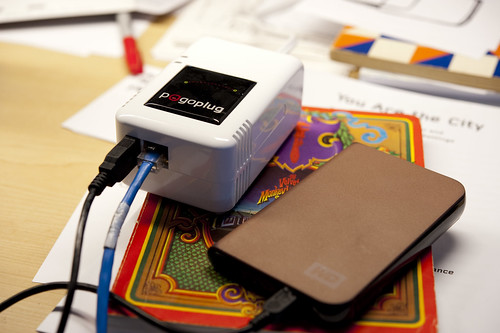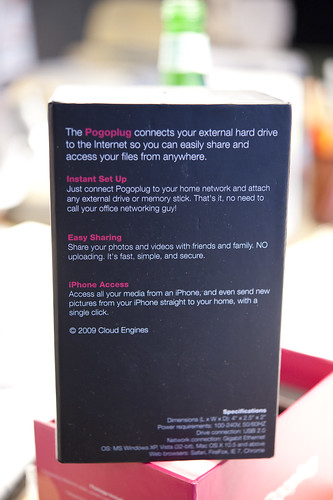
BTW lying under the tech is a first edition (1973) of the brilliantly quirky and prescientThe Velvet Monkey Wrench
Along with Augmented Reality, Cloud Computing seems to be one of the more thorough-going technology memes these days. The concept is consistent with the logic of the network. As bandwidth speeds level-up, and bandwidth costs go down (not free, just less, despite what Chris Anderson hypes) the asymptotic extreme approaches a curious quandary: where should “processing” be placed in relation to “data”?
Imagine if data can move (or appear to move) fast enough between where it is consumed and created such that it doesn’t actually matter where it lives? That might mean that I don’t have to lug around lots of big portable computing power — I can use a svelte device with just a sliver of CPU and enough screen to see what I need to see. No hot, power-hungry hard drive. Etc.
I’m curious about this intersecting graph and so decided to introduce an experiment using this newly available Pogoplug device. Effectively it’s a condensed bit of pre-existing technology wonderfully packaged into simple oneness. Simple oneness — my half-assed way to describe the Pogoplug without referring to it as either “smart”, as an “appliance” or a “smart appliance.” It’s only smart in the degree to which it does not make me feel dumb.
I have to say, it certainly appears clever in a number of ways. First of all, it does something obvious, and I mean that this way: the bits of technical kit required to make ones data appear close to one no matter where one is, within the constraints of reasonable access to networks and so forth — this has been around for quite some time. I can remember — and I’m sure every geek with an itch to not just speculate but live a bit in the future — I can remember cobbling together this and that to get my screen, my data and my command prompt to appear and be accessible from other places. It was all there, all the little packages and so forth — it was just an unpleasant, distasteful peasants stew. Pogoplug adds some robust seasoning. I didn’t have to touch a thing except to plug everything together, copy a unique identifier found in the box into a web form — and the Pogoplug mothership found my unit, prompted me to pick a username and password and then I saw a web interface to all the drives I had plugged into the unit. Nice, simple, surprising.
There’s a bit of software for Windows and OS X to allow the drives to appear like ordinary desktop storage, making drag-and-drop and browsing quite familiar. I can assign files to be shared to specific people — there are no global permissions it appears, which is just fine with me. Although, one interesting aspect of this is a possible shift in the locality of served data. I’m curious about this — rather than data living in the more typical, canonical places like data centers, does it distribute in a fashion, so that your data is accessed at its place of origin, or where you decide to keep it and perhaps you like to keep it close by or even under your mattress or the equivalent in the networked age. And perhaps it is served up and processed more locally, such as at my home, in my car’s computer, directly from my mobile computer or mobile phone or even from my camera.
It’s just a speculation, but a more distributed network of nodes is a peculiar inversion of the typical run and hype of cloud-y things, which implores us to move everything into one or two or many clouds run by cloud service providers. What about an infinity of highly localized service points? What about my front doormat? Should it be a service provider? Can the guys who insist on bringing door hanger adverts for the local Thai restaurant just upload it to my door handle instead? Save the paper? Can I unsubscribe to the inevitable digital version of the crappy real estate newspaper that appears on the lawn in the morning?
I don’t know the specific advantages this might offer when measured against the usual metrics of the technology business — faster, cheaper, more profitable — but I enjoy the concept of keeping my stuff — data, touch points, access ways — close to me, nearby, on me, in my devices, etc. There are times when I feel like I am too trusting when I put it off somewhere I don’t even have physical access to. Perhaps my furniture secures my stuff, hidden in the overstuffed arm rest of my reading chair or something?
The Pogoplug and its bubbling Pogoplugged blog community also has its Openpogo variant, a DIY, opensource community of more eager tinkerers who have some mechanisms for changing the Pogoplug into a variety of other things through software enhancements and adjustments and tuning and hot-rodding so forth. You can SSH to the thing (*palms sweating*), install packages (*stomach knotting*) and all that sort of thing which is exciting. You can do things like run HTTP services on the device, install streaming media services to get your content to appear on game consoles — all the usual technogadgetygeekery and lots of happy campers who have been trying to do all this kind of stuff with repurposed stuff computation “forever”. (Lord knows what they’ll do now that that problem has been taken care of. Maybe, I dunno — a two state solution to Isreali/Palestinian peace via torrent sharing or something.)
Another curious thing about Pogoplug that I read a month or so ago when I first ordered it was that, after some concerns from initially excited pre-ordering people, the Pogoplug people put in effect a provision to move their core software into an open source framework should the company fail. (Can’t find this discussion, but I’d be curious to locate it if someone comes across it.) This is quite intriguing — effectively a kind of corporate last will and testament that provides an opportunity for the device to avoid complete obscurity and obsolescence in the event of corporate failure. I found this quite interesting. I am not sure if the Openpogo community thing makes this unnecessary in a practical sense, but the fact that this was considered and executed was a quite a thing in my mind. A new sort of design principle or something explicitly providing for re-use or re-vitalization of some kind.

It’s a bit of a fantasy in the extreme — I still don’t believe the ad with the beach in the background and someone sitting with their computer under an umbrella, Mojito elegantly perspiring nearby. But in a practical sense, I like the idea of being able to put the different bits hither-and-yon. I’ll keep my data, which is what matters to me, in a safety deposit box that — because my bank is forward thinking and wanted to add a useful new service tier — has a little bit of power and an RJ45 network jack in it. My data is safe and sound in a locked, climate controlled box. I’ll take on the responsibility and I feel more trusting minding my own hardware rather than shooing it off into an anonymous data center. It’s a kind of peculiar future where banks become a different sort of hybrid entity, relying on their existing physical infrastructures and holding onto a new, different kind of value — my data. It’s not the cloud model, where the data is floating up out of reach. It’s more like a fog, down on the ground, more local, nearby and amongst me. (I’m not actually proposing a metaphor change, but names and imagery matter, I suppose.)
The “cloud” metaphor for Cloud Computing never quite seemed right to me. It’s ephemeral and flighty. But, I guess also light — and a nicely drawn cloud is evocative of dreams and sitting on a lovely knoll having a picnic. Clouds — the kind that float in the sky — consist of tinder droplets of water vapor and so last about five minutes before they evaporate themselves into other forms, and that’s where the metaphor breaks down for me. (Required reading for anyone who finds themselves saying “cloud computing”, mantra-like — would be The Cloudspotter’s Guide: The Science, History, and Culture of Clouds. Really, it’s a fun read and you should know what idioms and science and history and culture you are invoking, anyway.)
Why do I blog this? Some first impressions of this impressive little zero-conf device that activates a number of intriguing principles that run counter to the larger, advertised vision of cloud computing. The device is great for what it does, and if you want to do this sort of thing I thin out your computing, its certainly easy to get it all going. Here in the Laboratory it provides a physical device with which to think about future models of interaction rituals and mechanisms for experimenting with what data could become. So far I am quite impressed with the concept and definitely its execution. A nice laboratory instrument.
I like this solution to network storage/portable web server. http://www.serversman.com/index_en.jspThe app is free and darn close to zero configuration. I supose there is the ongoing cost of the iPhone network access to consider.
Well, you sold me! On Pogoplug and that John Muir book both. (Seriously. I even bought a better-quality “collectible” used copy from Amazon Marketplace because it seems like a book that will remain interesting for a long time.)
Very interesting end-of-company-life proposal, that, turning over your work to open source. It’s a pretty nice way of hedging your bets.
And I like your use of the phrase “simple oneness”; no need to apologize for it, really. It’s a completely legitimate advantage in terms of product design.